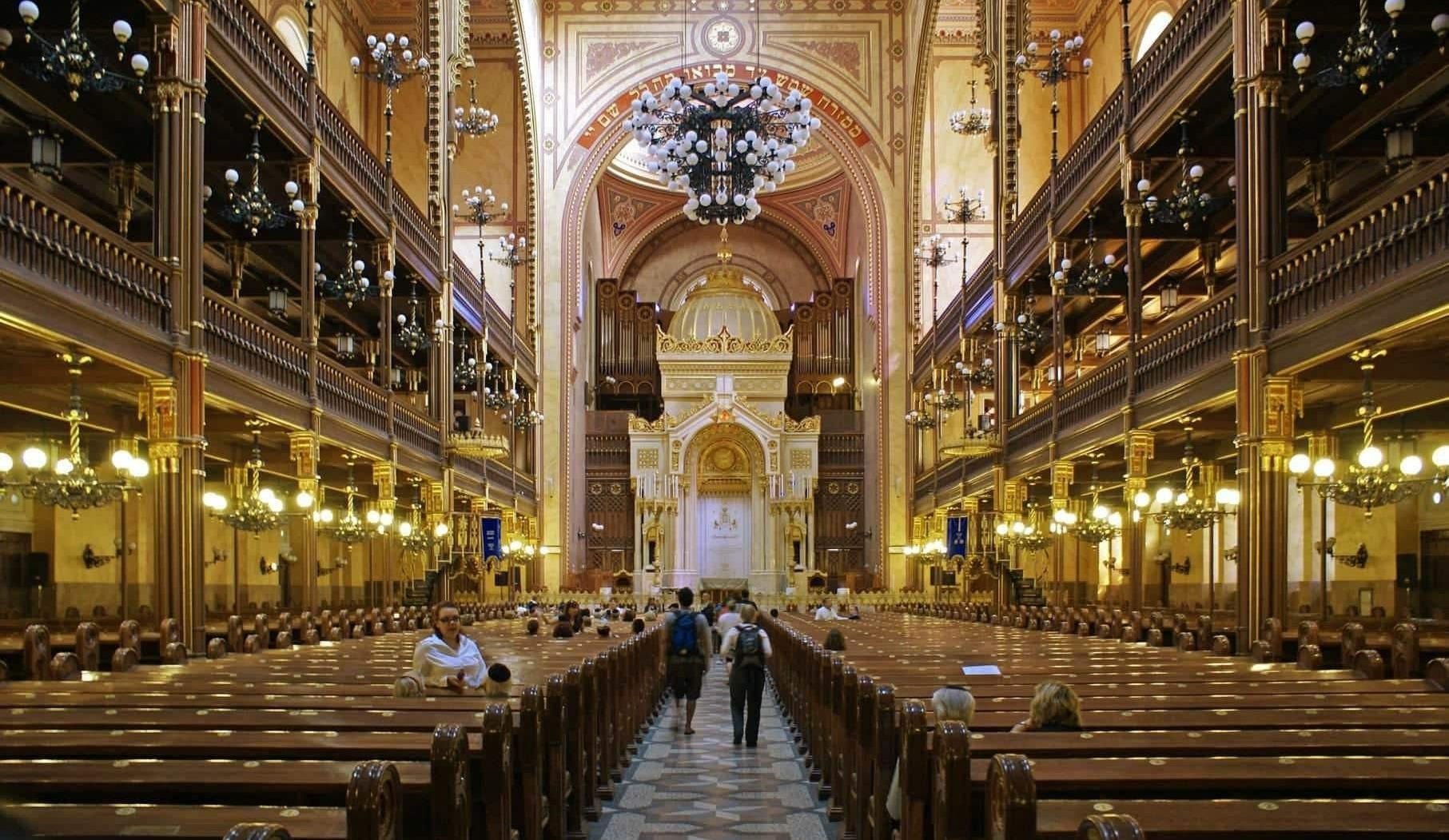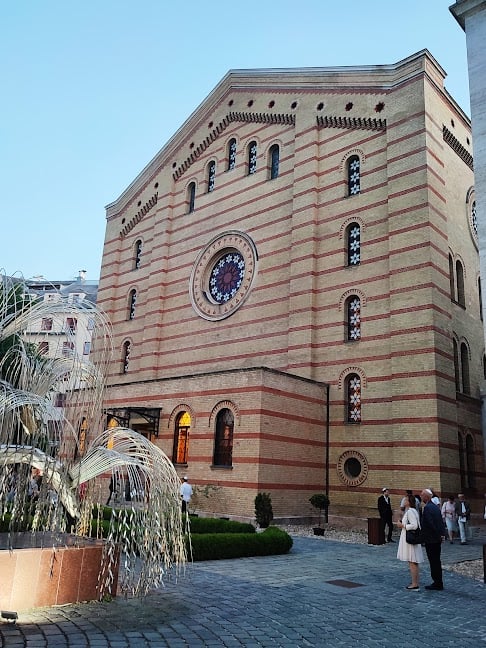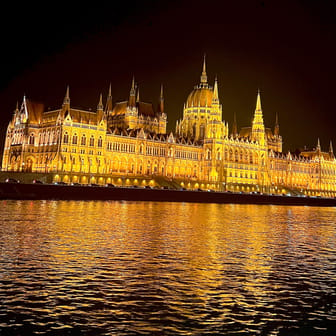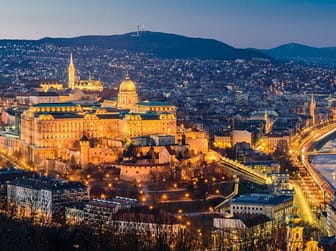Dohány Street Synagogue





Ask ThatchGPT
Suggest a local expert to plan my trip
Suggest an unique itinerary for my Budapest trip
What foods do Budapest locals eat
What are some true hidden gems in Budapest
Help me brainstorm trip ideas for Budapest
Help me plan a family-friendly trip to Budapest
What people say
Pedro Pereira
Available for hire
"Constructed between 1854 and 1859, the synagogue was designed by Ludwig Förster in a blend of Moorish Revival and Romantic Historicist styles, incorporating elements inspired by Islamic architecture from North Africa and medieval Spain, including the Alhambra. The synagogue was intended as a monumental statement of the Jewish community's presence in the city and was consecrated on September 6, 1859. At the time of its completion, it was the largest Jewish place of worship in the world.
During World War II, the synagogue suffered damage from bombing raids, particularly from the Hungarian pro-Nazi Arrow Cross Party. It was repurposed as a stable and radio base by the occupying forces. Despite this, it remained a place of prayer for the Jewish community during the Communist era. After the fall of Communism, extensive restoration efforts began in 1991 and were completed in 1998, funded through both state and private donations.
The Dohány Street Synagogue measures 75 meters (246 feet) in length and 27 meters (89 feet) in width, with its façade dominated by twin octagonal towers topped by onion domes. The design incorporates a mix of architectural styles, including Byzantine Revival, Romanesque Revival, and Gothic Revival, with the most prominent being the Moorish Revival, evidenced by the alternating red and yellow brickwork. The rose window above the main entrance and the presence of Jewish symbols, like the Star of David and the Stone Tablets, are part of the external decoration.
Inside, the synagogue features three aisles, with the seats arranged in a traditional manner, where men sit on the ground floor and women on the upper gallery. The interior is richly decorated with colored and golden geometric frescoes, and the Torah ark, designed by architect Frigyes Feszl, houses Torah scrolls salvaged from synagogues destroyed during the Holocaust.
One of the synagogue's unique features is its pipe organ, an instrument not commonly found in Jewish places of worship. The original organ, built in 1859, was played by composers such as Franz Liszt and Camille Saint-Saëns. A new 63-voice organ was installed in 1996, and it remains a significant part of the synagogue's musical heritage.
After decades of damage and neglect, the synagogue underwent a major renovation starting in the early 1990s, which was completed in 1998. The restoration was supported by the Hungarian government, as well as Jewish-American philanthropists such as Estée Lauder and Tony Curtis. Today, the synagogue complex includes the Heroes' Temple, a Jewish museum, and a cemetery, and serves as a major cultural and religious center for the Jewish community in Budapest.
The Dohány Street Synagogue remains one of the most important landmarks in Budapest, reflecting both the rich cultural heritage of Hungary's Jewish community and the resilience of its people through turbulent historical periods."
Read more in:
Keren
"Situada en la calle Dohány, la Sinagoga de la Calle Dohány es un tesoro cultural que cautiva desde su construcción. Testigo de la rica historia judía en Budapest, este lugar es mucho más que un edificio religioso.
Su arquitectura impresionante, combinando estilos como el morisco y el romántico, crea una atmósfera única. La Sinagoga es la más grande de Europa y ha sido un punto clave en la vida judía de Budapest.
Sumérgete en su interior, donde frescos y detalles ornamentales dan vida a la historia. El jardín conmemorativo y el Museo Judío contiguo añaden capas de significado a tu visita.
Recomendamos explorar sus alrededores, donde el Espacio Emanuel y el Árbol de la Vida ofrecen momentos reflexivos. Además, la Sinagoga acoge eventos culturales, enriqueciendo aún más tu experiencia.
La Sinagoga de la Calle Dohány es un recordatorio de la diversidad cultural de Budapest y una invitación a explorar la historia judía en un entorno que trasciende lo religioso."
Sofia B
Available for hire
"Also known as the Great Synagogue or Tabakgasse Synagogue
The Budapest Synagogue was built between 1854 and 1859 according to the moorish style and is the largest synagogue in Europe and the second largest synagogue in the world. It can seat 3.000 people and it is located in the Jewish Quarter of Pest.
Price: 10800 huf / €27,5
Opening hours:
Winter season:
Sunday - Thursday: 10:00 am - 4:00 p.m
Friday: 10:00 am - 2:00 p.m
Saturday: closed
Summer season:
Sunday - Thursday: 10:00 a.m - 8:00 p.m
Friday: 10:00 a.m - 4:00 p.m
Saturday: closed
"
Read more in:
Mentioned in these guides
About Dohány Street Synagogue
Get the inside scoop on Dohány Street Synagogue from local experts, travel creators, and tastemakers. Browse genuine trip notes, Dohány Street Synagogue reviews, photos, travel guides, and itineraries from real travelers and plan your trip with confidence.
Phone
Save this spot for later or start mapping out a new trip today
Try our AI Travel Assistant and get instant answers to any questions about your trip.
Ask ThatchGPT


